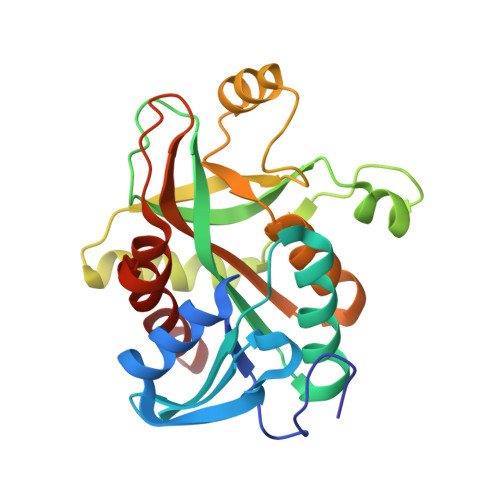Open and closed conformation of the E. coli purine nucleoside phosphorylase active center and implications for the catalytic mechanism.
Koellner, G., Bzowska, A., Wielgus-Kutrowska, B., Luic, M., Steiner, T., Saenger, W., Stepinski, J.(2002) J Mol Biol 315: 351-371
- PubMed: 11786017
- DOI: https://doi.org/10.1006/jmbi.2001.5211
- Primary Citation of Related Structures:
1K9S - PubMed Abstract:
The crystal structure of the ternary complex of hexameric purine nucleoside phosphorylase (PNP) from Escherichia coli with formycin A derivatives and phosphate or sulphate ions is determined at 2.0 A resolution. The hexamer is found as a trimer of unsymmetric dimers, which are formed by pairs of monomers with active sites in different conformations. The conformational difference stems from a flexible helix (H8: 214-236), which is continuous in one conformer, and segmented in the other. With the continuous helix, the entry into the active site pocket is wide open, and the ligands are bound only loosely ("open" or "loose binding" conformation). By segmentation of the helix (H8: 214-219 and H8': 223-236, separated by a gamma-turn), the entry into the active site is partially closed, the pocket is narrowed and the ligands are bound much more tightly ("closed" or "tight binding" conformation). Furthermore, the side-chain of Arg217 is carried by the moving helix into the active site. This residue, conserved in all homologous PNPs, plays an important role in the proposed catalytic mechanism. In this mechanism, substrate binding takes place in the open, and and the catalytic action occurs in the closed conformation. Catalytic action involves protonation of the purine base at position N7 by the side-chain of Asp204, which is initially in the acid form. The proton transfer is triggered by the Arg217 side-chain which is moved by the conformation change into hydrogen bond distance to Asp204. The mechanism explains the broad specificity of E. coli PNP, which allows 6-amino as well as 6-oxo-nucleosides as substrates. The observation of two kinds of binding sites is fully in line with solution experiments which independently observe strong and weak binding sites for phosphate as well as for the nucleoside inhibitor.
Organizational Affiliation:
Freie Universität Berlin, Institut für Chemie-Kristallographie, Takustrasse 6, D-14195 Berlin, Germany. koellner@chemie.fu-berlin.de

















